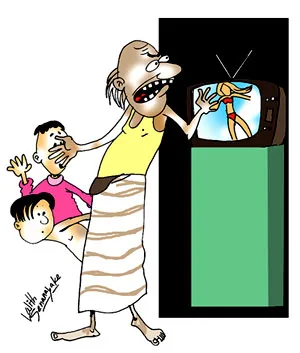The previous part of this blog introduced the community standards test in the obscenity jurisprudence and suggested that it has been inconsistently applied by the Indian courts, thereby necessitating a more nuanced understanding of obscenity.
The Chameleonic Nature of Obscenity: A Case for Variable Obscenity
“The material categorised as obscene is always obscene at all times and places and in all circumstances, or whether obscenity is a chameleonic quality of material that changes with time, place and circumstance.” –Professor Lockhart and McClure
This provocative question by Prof. Lockhart and McClure articulates the concept of variable obscenity. Building on the theoretical foundation of this concept, the authors propose three core questions that the Indian courts should ask while judging cases of obscenity: the purpose of the distributor, the manner of distribution, and to whom the material is distributed.
A. Purpose of the Distributor
The notion that the same material might be distributed for different purposes forms the genesis of variable obscenity. This tenet of variable obscenity does not judge a material in isolation but also takes into account the intent or the purpose of the disseminator.
Taking into account the controversial case of Rehana Fatima, a Kerala-based activist who had posted a video titled “Body and Politics” in 2020, wherein her son was seen painting on her semi-nude torso. The post was perceived as obscene by the authorities leading to her arrest. However, her contention was that the video was made and posted to challenge the conservative mindset for sexualising the female upper body, to which the naked male upper body was not subjected to. The Kerala High Court, while agreeing with her contention, observed that the authorities completely overlooked the message it wanted to convey.
B. Manner of Distribution
Obscenity is not just about what is shown, but also about how and in what manner it is presented or distributed. For instance, explicit acts in a movie without disclaimer might be considered obscene but the same can be deemed acceptable with proper content ratings and accurate disclaimers.
For instance, in March 2024, the Indian Ministry of Information and Broadcasting (I&B) took stern actions against 18 OTT platforms accused of streaming obscene content without proper content warnings and age restrictions, making explicit material accessible to all. These actions reflect the fact that the material in question is not only evaluated on the basis of the content that is being disseminated but also about how responsibly it is being shared.
C. To Whom the Material is Distributed – The Targeted Audience Test
Variable obscenity, by its very nature suggests that a thing may not be obscene for a particular group of individuals but can be deemed so for some other group.
The Courts have long proposed and supported the average-person test or the reasonable person test which is a core tenet within the community standards test. However, this test has a fundamental flaw. Why should “the average person” always be the proper person to whose prurient interest the material must appeal? A particular piece of material does not cater to each and every person in the same way. While an individual may find a certain material distasteful, his distaste for the object may not stem from its inherent obscenity, but because, according to that individual, it threatens a value they cherish.
A relevant example would be a stand-up comedy show. These shows are often alleged to have created obscene content but it is often ignored that different audiences have varying thresholds for satire. Applying a generalised standard to determine whether a particular thing is bad and corrupt falls short of delivering justice in such cases.
The targeted audience test is based on the principle that applying a one-size-fits-all standard ignores the fact that the content is often created for a specific audience. The US Supreme Court in the case Mishkin v. New York, observed that the average-person test has certain weaknesses when a material is intended to appeal to a deviant group. The Court opined that in such cases; the average person test should be substituted with the perception of the average member of that deviant group.
An adult-oriented content with clear content warnings and age restrictions should be evaluated on the basis of the consenting or the viewing audiences and not the general public. This is because the content itself was not made for the general public but for a specific audience.
Applying the variable obscenity test to the recent case of India’s Got Latent would yield a result in the following manner. Firstly, the purpose of the show was to make people laugh. Although the jokes were centred around sexuality, this alone does not warrant labelling it as obscene. Secondly, the show required a subscription-fee, meaning it was not freely accessible to the general public. Thirdly, the fact that it was subscription-based reinforces the idea that it was intended for a specific audience who was willing to watch it rather than the public at large.
Conclusion
While the concept of variable obscenity is particularly important in a country as diverse as India, its application is not without its own set of challenges.
The first issue being that allowing targeted audiences to dictate acceptability of a specific content might weaken the obscenity laws, potentially leading to the normalisation of material that is dehumanising or degrading. Some may argue that a blanket ban of violent pornography is unjustified if such content websites have disclaimers, age restrictions, and require prior consent, implying that the willing viewers can be deemed as the intended audience.
One such example is related to the brutal rape incident that took place in RG Kar Hospital in Kolkata. In an investigation by India Today’s Open Source Investigation team, it was revealed that following the crime, a plethora of web searches was related to “porn”. Disturbingly, even keywords like “rape porn” were also used. This underscores a very harsh reality that the mere willingness of an audience to consume a content does not warrant its unrestrictive dissemination.
Secondly, in this digital era, content intended for a niche audience can easily be spread beyond its intended viewership through social media and re-uploads.
Despite these challenges, the variable obscenity approach takes a more nuanced understanding and protects the freedom of expression of content creators, allowing for some deviation from the community standards if their intended audience is comfortable with such content.
Sayed Kirdar Husain is a 3rd Year student at RGNUL, Punjab. His areas of interest include Technology and Data Privacy Laws and Public Law.
Aayush Khanna is a 3rd Year student at RGNUL, Punjab. His areas of interest include Competition Law and Public Law.
[Ed Note: This piece was edited by Hamza Khan and published by Baibhav Mishra from the Student Editorial Team.}







profesyonel su kaçak tespiti Küçük bir sızıntıyı bile tespit etmeleri çok etkileyiciydi! https://social.sustpressclub.org/read-blog/14039
Barbaros Hayrettin Paşa su kaçak tespiti Beyoğlu’ndaki binamızda tespit ettikleri su kaçağını hızlıca onardılar. Herkese öneririm. https://community.gantner.id/read-blog/8828
Wonderful web site Lots of useful info here Im sending it to a few friends ans additionally sharing in delicious And obviously thanks to your effort
Sultanbeyli su kaçağı tespiti Banyo ve mutfak alanları su kaçağına en çok maruz kalan yerlerdir. https://trackrecord.id/read-blog/16414
Your writing has a way of resonating with me on a deep level. I appreciate the honesty and authenticity you bring to every post. Thank you for sharing your journey with us.
Excellent blog here Also your website loads up very fast What web host are you using Can I get your affiliate link to your host I wish my web site loaded up as quickly as yours lol